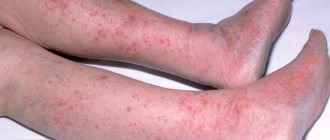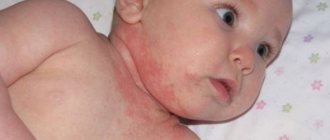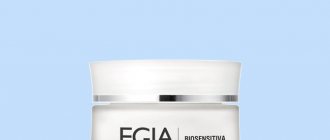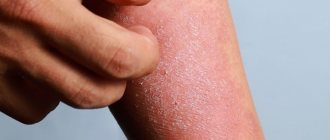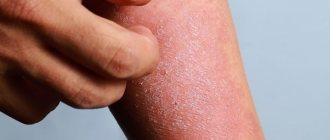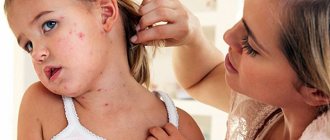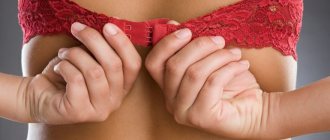Pruritus, the most common dermatological complaint, is characterized by an unpleasant sensation with a continuous need for a response of mechanical irritation of the skin, as a result of which it can cause effects such as skin damage, secondary infection, and scar formation. Itching can also significantly affect the general condition and quality of life of patients, causing emotional disturbances, insomnia, anxiety, and in severe cases, depression and suicidal thoughts [1].
Itching is one of the most common subjective symptoms in dermatology, second in prevalence only to complaints about cosmetic defects. With atopic dermatitis and urticaria, 100% of patients complain of itching, with psoriasis - up to 87% of patients [2]. According to clinical and epidemiological data from H. Alexander et al. [3], 35% of skin clinic outpatients suffer from itching caused by dermatological diseases such as prurigo nodosum, lichen planus, atopic dermatitis, eczema, xerosis, etc.
There is both histamine-induced and histamine-independent itching. Histamine-induced is caused by mechanical, thermal, electrical or chemical stimulation of unmyelinated histamine-sensitive peripheral C-type nerve fibers. Nonhistamine nerve fibers are also involved in the transmission of the itch signal, and therefore many forms of itch are insensitive to antihistamines. Itching is one of the forms of the skin analyzer, close to other types of skin sensation (touch, pain). Severe itching is relieved by severe self-harm, leading to the replacement of the sensation of itching with a feeling of pain [4, 5].
In this regard, it is worth mentioning the vicious cycle of itching—scratching—itching. Damage to the skin barrier and subsequent inflammation lead to the development of itching. In the skin, inflammatory cells activate sensory nerves, mast cells, fibroblasts, and macrophages. All of the above cells release itch mediators, which further increase inflammation. The itch signal is transmitted to the brain, causing the scratch reflex. Scratching further damages the skin barrier and increases inflammation. T lymphocytes and eosinophils migrate into the skin, releasing pruritogen mediators. Ultimately, sensitization of sensitive nerve fibers occurs and the activation threshold decreases. Growth factors released by eosinophils cause proliferation of nerve fibers. These changes increase the sensitivity of the skin, which becomes even more vulnerable to endo- and exogenous factors. This cycle is difficult to break. The itch-scratch-itch cycle leads to disturbances in sleep, concentration and perception, thereby limiting the social activity of patients [6].
Clinical picture
Subjectively, patients characterize itching as a “crawling” sensation, tingling, slight burning of the skin, etc. The intensity of itching can vary: from mild to severe. Itching leading to sleep disturbance is considered severe. Biopsy itch is a severe itch in which scratching leads to significant self-damage to the skin. With this form of itching, the pain that appears when excoriating the skin brings satisfaction. Clinically, the patient's condition with prolonged itching will be characterized by excoriations (linear skin lesions with hemorrhagic crusts), post-inflammatory pigmentation, scars, lichenification, and secondary pyoderma. Prolonged itching negatively affects the general well-being of the patient: the development of insomnia and associated nervous system disorders are possible [7].
The fastest possible relief and cessation of itching is a priority in the treatment of itchy dermatoses. Symptomatic therapy for itching should be prescribed as early as possible to interrupt its cyclic course. Therapy for itching should be effective and safe, well tolerated by patients and have a positive effect on quality of life [8].
For what reasons does dermatitis develop?
The disease manifests itself in the form of an allergic reaction to any irritant.
The development of dermatosis can be influenced by the following factors:
- – chemicals (cleaning agents, cosmetics, perfumes, acids);
- – physical (sun rays, ultraviolet radiation, prolonged contact with water, radio waves, sudden temperature changes);
- – biological (medicines, herbal medicines);
- – food (consumption of allergen products: citrus fruits, strawberries, nuts, bee products);
- – obligate (alkali, poisons, acids).
Skin diseases can be inherited. If the disease is transmitted from a parent to a child, then the nature of this dermatitis will be chronic.
Dermatitis can occur against the background of impaired gastrointestinal functions, hormonal imbalance or psycho-emotional stress. Polluted air contains many harmful substances that can cause dermatitis.
Material and methods
The clinical study was conducted from October 2022 to April 2019. This study was an open comparative study. The study included 40 patients of both sexes aged from 7 to 43 years with itchy dermatoses in the acute stage with and without weeping, including those complicated by secondary infection, with comparable lesions on the mirror parts of the body. 27 patients were diagnosed with atopic dermatitis, 2/3 of them having moderate to severe degrees; 13 patients sought consultation due to exacerbation of hand eczema. Diagnosis of dermatoses was based on a comprehensive assessment of clinical and anamnestic data.
Before starting and during treatment, a clinical assessment of the patient’s condition was carried out:
1. Assessment of subjective clinical signs (patient complaints): itching of the skin, burning, soreness and insomnia. Itching of the skin and the antipruritic effect of therapy were assessed for each half of the body using several parameters:
a) intensity of skin itching according to VAS (10-point system);
b) time (in minutes) after which the itching stops; duration of antipruritic action after morning application of the product;
c) severity of itching, frequency of attacks of itching, duration of itching (assessed over the last week).
2. Assessment of objective signs of inflammation: erythema, swelling, crusts/weeping, excoriation, lichenification, dry skin, cracks/erosions.
3. Assessing the effectiveness of therapy by a doctor:
a) pronounced improvement - resolution of old elements, absence of itching and soreness of the skin;
b) improvement - incomplete resolution of old elements, absence of itching and soreness of the skin;
c) state without change - no changes in the skin;
d) deterioration - deterioration of the clinical picture, the appearance of itching, soreness of the skin.
4. Dermatological quality of life index (DIQL).
The examination was carried out 5 times (once every 2-3 days) for 12-16 days. All patients applied a topical glucocorticosteroid (Akriderm cream) to the affected areas of the skin of one half of the body 2 times a day (morning and evening), lightly rubbing; two drugs were applied to the lesions of the second half of the body - Neotanin
(spray/lotion/cream) and Akriderm cream.
Neotanin
cream was prescribed to 18 patients,
Neotanin
- 12,
Neotanin
- 10. First,
Neotanin
in a thin layer to the affected area of the skin 3-4 times a day. After application, wait until the treated surface dries. After 15 minutes, 2 times a day (morning and evening), apply a thin layer of Akriderm cream to the affected area of the skin, lightly rubbing.
During the study, the prescription of topical (except Akriderm) and systemic glucocorticosteroids, antihistamines and antibacterial drugs, and antiseptics was not allowed. Some patients additionally received concomitant therapy: choleretic, systemic desensitizing agents, external emollients.
Permission from the Ethics Committee was obtained to conduct the study.
For statistical processing of data, the Mann-Whitney, Wilcoxon tests (to assess dynamics), χ2 or two-sided Fisher's exact test were used.
Benefits of La Roche-Posay pharmacy cosmetics
La Roche-Posay pharmacy brand products are professional cosmetics for home care for reactive skin of various types, approved by dermatologists and developed taking into account innovative achievements in cosmetology and pharmaceuticals.
The effectiveness of the patented formulas of La Roche-Posay skin care ranges has been proven by independent clinical studies and is designed to solve the problem of skin imperfections at the cellular level. Unlike cosmeceuticals, conventional creams mask the external manifestation of skin imperfections without eradicating the problem.
results
After therapy, all patients showed positive results, however, the dynamics of itching and signs of inflammation when using combination and monotherapy had statistical differences.
Thus, on lesions where combination therapy was used ( Neotanin
+ Akriderm), the intensity of itching by the 3rd day of the study decreased by 60% (from 10 points to 4), with monotherapy with Akriderm - only by 22% (from 9 points to 7;
p
= 0.02) (Fig. 1).
Rice.
1. Intensity of itching (on a 10-point scale). According to the daily diaries of patients, in areas of the body where Neotanin
, the itching stopped much faster: after 8-15 minutes - compared to monotherapy with Akriderm, in which the cessation of itching was observed on average only after 60 minutes (
p
<0.01) (Fig. 2).
Rice. 2. Time to relieve itching after applying the drug, min. The duration of antipruritic action after application of Neotanin
+ Akriderm was on average 2-3 hours, Akriderm - only 30 minutes (
p
<0.01) (Fig. 3).
Rice.
3. Duration of antipruritic action after application, min. Thus, the duration of antipruritic action (time for resolution of clinical manifestations) with combination therapy of Neotanin
with a topical glucocorticosteroid is 4 times higher compared to monotherapy with a topical glucocorticoid (Fig. 4).
Rice. 4. Terms of resolution of clinical manifestations when using combination therapy compared to monotherapy with a topical glucocorticosteroid: a) in a 35-year-old woman with moderate atopic dermatitis (exacerbation); b) a 35-year-old woman with acute eczema of the hands.
Rice. 4. Terms of resolution of clinical manifestations when using combination therapy compared to monotherapy with a topical glucocorticosteroid: c) in a 25-year-old woman with mild atopic dermatitis (exacerbation).
Frequency of itching on the half of the body to which Neotanin
+ Akriderm, by the end of the 1st week decreased by 75% - from the indicator “very frequent itching” to the indicator “rare itching”;
in the area of application of Akriderm by 25% - from the indicator “very frequent itching” to the indicator “frequent itching” ( p
<0.01).
The severity of itching was assessed on a scale from 0 to 4 points, where 0 points means no itching, 4 means severe itching. At the 1st visit, the average score was 4 on each side. By the end of the 1st week, on the areas of the body where Neotanin
+ Akriderm, severity of itching decreased to 2 points (mild itching);
Akriderm - up to 3 points (moderate itching) ( p
<0.02).
Each of the signs of inflammation (erythema, edema, oozing, excoriation, lichenification and dryness) was assessed on a scale from 0 to 3 points, where 0 points means no symptom, 3 means a pronounced symptom. The intensity of inflammation was determined by the sum of scores of all signs. The intensity of skin inflammation on the 7th day of treatment decreased by 50% on skin areas after application of Neotanin
+ Akriderm, by 22% - in areas with monotherapy with glucocorticosteroids (
p
<0.01).
In addition, during monotherapy with Akriderm, in 3 patients an exacerbation of the skin process was recorded on the 5th-7th day of therapy, in 1 patient a bacterial infection was noted on the skin area.
In general, during treatment, an increase in the quality of life was found in almost all patients included in the study.
On areas of the body where Neotanin
+ Akri-derm, the effectiveness of therapy on the 4th visit (10th day) was assessed by the doctor in 37 (92.5%) patients as a marked improvement, in 3 (7.5%) - as an improvement. After using Akriderm, the indicators were as follows: in 7 (17.5%) patients there was a marked improvement, in 27 (67.5%) there was an improvement, in 5 (12.5%) there was no change, in 1 (2.5%) %) - deterioration.
DIQL was measured at the beginning and at the end of treatment: a decrease was noted from 21 points (the disease has an extremely strong impact on the patient’s life) to 9 (the disease has a moderate impact on the patient’s life).
Assortment of pharmaceutical cosmetics La Roche-Posay
You can buy La Roche-Posay dermatocosmetics in city pharmacies or order delivery from the manufacturer’s online store. The range is presented in several ranges for different types and needs of facial and body skin.
Below are the most popular La Roche-Posay ranges according to customer reviews for 2022:
- EFFACLAR
– cosmetics for oily and problem skin; - LIPIKAR
– cosmetics for dry atopic skin; - TOLERIANE
– care for sensitive and allergic skin; - CICAPLAST
– soothing multi-regenerating cosmetics for face and body; - HYALU B5
– moisturizing anti-aging care; - ROSALIAC
– care for reactive skin prone to redness; - ANTHELIOS
– sun protection.
The prices for active cosmetics also differ from the cost of store-bought cosmetic products. Often, medical cosmetics are more expensive, which is explained by patented production technologies, highly concentrated formulas and independent clinical studies confirming the high effectiveness of the products.
Discussion
Since during exacerbation of itchy dermatoses the leading symptom is largely itching, the prescription of antipruritic drugs is justified.
At the present stage, the most commonly used group of drugs is topical glucocorticosteroids, which have anti-inflammatory, antiallergic, and immunosuppressive effects. However, despite the creation of a new generation of topical glucocorticosteroids with minimal side effects, their application over large areas and for a long time leads to an increase in the steroid load on the skin and the development of its dystrophy. In addition, the antipruritic effect of topical glucocorticosteroids is often insufficient for rapid and long-term relief of itching.
Choosing an effective and safe drug for the treatment of pruritic dermatoses, which has a pronounced antipruritic effect, turned out to be a difficult task. In our choice, we settled on the Neotanin series of drugs,
including lotion, spray and cream.
The main active components of the Neotanin
are synthetic tannin and polidocanol; zinc oxide is added to the lotion.
M. Puschmann and C. Matthies proved the antipruritic effect of tannin using the histamine blister test and stimulation of the lip mucosa [9, 10]. The histamine blister test was performed on 85 healthy volunteers. Due to the important role of skin mast cells as effector cells in immediate allergic reactions and diseases accompanied by itching, T. Zuberbier et al. [11] studied the effect of synthetic tannin on IgE —
dependent activation of human mast cells. The effect of tannin was manifested in a dose-dependent inhibition of anti-IgE-induced histamine release. The effect appeared to be more pronounced than that observed with dexamethasone. In addition to antipruritic, synthetic tannin has astringent, anti-inflammatory, antimicrobial effects, and reduces transepidermal water loss [12].
The second active component of the Neotanin
is polidocanol, which has an antipruritic effect. The antipruritic effect of polidocanol develops 5-10 minutes after application to the skin, the duration of action is on average 3-4 hours. Polidocanol also enhances the astringent, drying effect of tannin, promotes the healing of erosions, has an anesthetic effect on the skin and mucous membranes, reduces sensitivity and conductivity sensory nerves. Polidocanol as an antipruritic and local anesthetic is included in the European Guidelines for Chronic Itching (2012), Recommendations of the Association of Scientific Medical Societies in Germany (AWMF) for the diagnosis and treatment of atopic dermatitis (2016), Recommendations of the European Dermatological Forum (EDF) on the treatment of atopic eczema / atopic dermatitis (2018) [13-15].
Why do dermatologists recommend using medicinal cosmetics?
Mass market products only affect the epidermis, while the formula of pharmaceutical cosmetics penetrates into the deeper layers of the dermis, bypassing the basement membranes. Pharmacy cosmetics are produced taking into account the standards for medical products, based on global manufacturers.
Pharmacy facial cosmetics are not addictive. Cosmetologists and dermatologists recommend using pharmaceutical cosmetics daily to visibly improve the condition of the skin.
An important advantage of pharmaceutical cosmetics is the high quality of basic functions:
- cleansing;
- hydration;
- regeneration;
- rejuvenation;
- elimination of hyperpigmentation, etc.
Pharmacy product formulas are aimed at eliminating the problem from the inside. Unlike store-bought products, cosmeceuticals contain higher concentrations of highly targeted active ingredients, such as hyaluronic acid, retinol, peptides, enzymes, a complex of acids, vitamins and antioxidants.
Cheap analogues of expensive ointments for dermatitis
Not all patients can afford to buy expensive drugs, so they can be replaced with more affordable analogues:
- "Advantana" (analogue of "Atoxil") - 150 rubles;
- “Hydrocortisone” (analogue of “Lokoid”) – 40 rubles;
- “Betaderm” (analogue of “Celestoderm”) – 90 rubles;
- “Salicylic ointment” (analogue of “Exoderil”) – 30 rubles;
- “Videstim” (analogue of “Radevit”) - 150 rubles.
Before buying analogues, you should definitely consult a doctor and undergo an allergy test.
Prevention of skin diseases
The most effective method of prevention is complete isolation from the irritating substance. It is quite possible to reduce the risk of dermatitis. To do this you need:
- – use protective gloves when in contact with paints and varnishes, household chemicals and other irritants;
- – use a moisturizer, especially when the sun shines strongly;
- – use gentle household chemicals;
- – minimize stressful situations;
- – avoid strenuous physical activity;
- – use moisturizing soap;
- – use hypoallergenic shampoo;
- – in winter, be sure to wear gloves, especially in cold weather;
- – adhere to dietary nutrition;
- – do wet cleaning in the house every day;
- – wear clothes made of cotton fabrics.
These recommendations will help minimize the risks of dermatitis.
Correct application of ointment for dermatitis
The manifestation of its properties depends on the correct use of the ointment:
- Apply the product to clean, dry skin. The layer should be thin. Do not rub the product in, as such actions can harm the diseased skin.
- Treatment begins with gentle means. If they do not give a positive effect, the doctor may switch to stronger drugs.
- If any adverse reactions occur, you should urgently visit your doctor. Especially if hormonal drugs are used, because therapy with such drugs cannot be abruptly interrupted.
- Only a specialist should select an ointment. The type and form of dermatitis are taken into account.
Important! Competent treatment is possible only after a complete examination.
What types of dermatitis are there?
Depending on the influence of factors, dermatitis can be of several types. In adults, the most common are contact and allergic dermatitis. Atopic dermatitis is most common in children.
There is also:
- – actinic;
- – sunny;
- – eczematous dermatitis (develops on the hands).
All types of diseases are triggered by certain factors. For successful therapy, the cause of the development of dermatitis must be determined.
Contact dermatitis
Occurs as a result of hand contact with an irritant. Contact dermatitis can be allergic or simple. A simple form of the disease occurs as a result of a sharp change in temperature, the influence of chemicals and mechanical stress. Unpleasant symptoms occur directly in the area of contact.
Attention! The development of dermatitis on the hands is triggered by frequent use of chemicals and detergents. In this case, you should urgently stop using such substances. They can be replaced with natural remedies.
Symptoms of dermatitis directly depend on the allergen, which can be:
- – mechanical (bubbles, rashes, itching);
- – chemical (voluminous blisters burst and form a crust);
- – caused by cold (severe itching, peeling of the skin, burning, blue lesions).
Allergic contact dermatitis develops after hands come into contact with an external pathogen. The skin may become inflamed after contact with animals or plants.
In this case, the symptoms are always the same:
- – redness;
- – swelling;
- – bubbles (clear liquid inside);
- – the bubbles burst, forming a crust;
- – peeling is observed.
The main feature of contact dermatitis is that after the irritant is eliminated, the inflammation subsides. Gradually, complete recovery occurs.
Atopic dermatitis
It is quite difficult to establish the cause of the development of this species. In most cases, atopic dermatitis is chronic. Hereditary allergies can influence the development of the disease. Most often found in children.
The following factors can provoke the disease:
- – diseases of an infectious nature;
- – poor metabolism;
- – constant stress;
- - bad ecology.
With this type of dermatitis, inflammation occurs on the back of the hand and fingers. The acute form is accompanied by severe redness, swelling, severe itching and rashes. In the chronic form, the skin becomes dry and rough, very itchy and flaky. Bubbles form, which over time turn into wounds. They may leave scars.
Allergic dermatitis
Develops in people prone to allergies. In most cases, the cause of this type of dermatitis is a weak immune system, asthmatic bronchitis or bronchial asthma. This form of the disease is triggered by the body’s reaction to substances that enter the body.
The following substances can provoke allergic dermatitis:
- – pollen;
- – some food products;
- – medications;
- – plant esters;
- - dust.
Symptoms appear some time after contact with the irritant. The skin begins to become inflamed, red and swollen. Severe itching, blisters and rashes appear. Allergic dermatitis can affect not only the hands, but also other areas. In addition to these symptoms, a person develops a runny nose and finds it difficult to breathe. As a result of this form of dermatitis, urticaria develops.
Solar dermatitis
This is a fairly serious form of dermatitis. It develops after exposure of the skin to the sun. The skin begins to turn red, a small rash and painful sensations appear. Symptoms of solar dermatitis occur immediately after prolonged exposure to direct sunlight.
Actinic dermatitis
Occurs due to exposure to ultraviolet rays or radiation. It differs from other types in that it does not appear immediately. Symptoms can occur either after a few hours or after a few days. This fact depends on the duration of exposure. Most often, this type of disease occurs in welders and farmers. The manifestation of symptoms is due to the strength of the radiation.
Eczematous dermatitis
The allergic type of dermatitis can eventually transform into an eczematous form. This occurs after direct contact with metals or chemicals. Symptoms appear after a few weeks. The skin peels off, the affected area begins to turn red, itching and severe burning are felt. The disease must be treated urgently, otherwise it will develop into eczema. Constant discomfort negatively affects the nervous system.
conclusions
Skin diseases can occur in anyone. Most often it develops after direct contact with an irritant. Dermatitis is easily treated and causes virtually no complications.
The main thing is to diagnose the disease in time and begin proper treatment. The maximum effect will be achieved with complex therapy.
The selection of medications for the treatment of dermatitis should be carried out by a doctor. After identifying the irritant, you need to stop contact with it. In addition, you need to follow a special diet and carefully follow the doctor’s recommendations.
Tell everyone:
